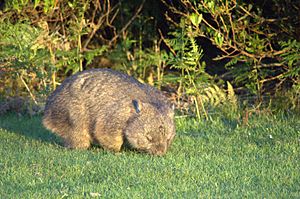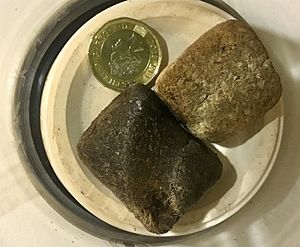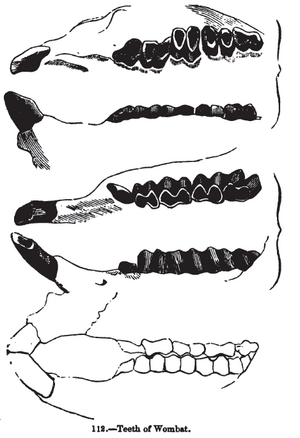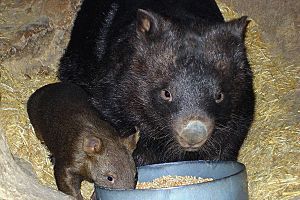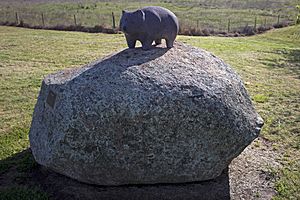Wombat facts for kids
Quick facts for kids Wombat |
|
|---|---|
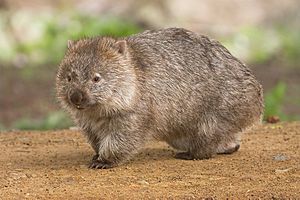 |
|
| Common wombat Maria Island, Tasmania |
|
| Scientific classification | |
| Genera and Species | |
|
Wombats are strong, short-legged animals from Australia. They are a type of marsupial, which means they carry their young in a pouch. Wombats are about 1 meter (3 feet) long and have small, stubby tails.
There are three types of wombats alive today. They all belong to the animal family called Vombatidae. Wombats can live in many different places. You can find them in forests, mountains, and open areas in southeastern Australia. This includes Tasmania. There is also a small group in Epping Forest National Park in central Queensland.
Contents
Wombat History and Family Tree
Scientists are still learning about how wombats evolved. Wombats are thought to have separated from other Australian marsupials a long time ago. This might have been as far back as 40 million years ago. Other ideas suggest it was around 25 million years ago.
The animal most closely related to the wombat is the koala.
Wombat Characteristics
Wombats are amazing diggers! They use their strong front teeth, which are like a rodent's, and powerful claws. They dig huge tunnels underground. A special thing about wombats is their pouch opens backward. This is helpful when they dig. Soil does not get into the pouch where their baby lives.
Wombats usually come out at dawn, dusk, or night. But you might see them looking for food on cool or cloudy days.
You might not see wombats often, but you can find signs they have been around. They can easily go through or under fences. They also leave behind unique cube-shaped droppings. Wombats use these droppings to mark their territory. They also use them to attract mates. Scientists think the cube shape helps the droppings stay in place and not roll away. An adult wombat can make 80 to 100 pieces of droppings in one night. Each piece is about 2 centimeters (0.8 inches) big.
Wombats are herbivores. This means they only eat plants. Their diet includes mostly grasses, sedges, herbs, bark, and roots. Their front teeth are good for gnawing on tough plants.
Wombats have fur that can be sandy, brown, gray, or black. All three types of wombats are about 1 meter (3 feet) long. They weigh between 20 and 35 kilograms (44 to 77 pounds).
Wombat Reproduction and Life Cycle
Female wombats usually have one baby in the spring. The baby stays in its mother's pouch for about six to seven months. Wombat babies drink milk for about 15 months. They are ready to have their own babies when they are about 18 months old.
A group of wombats can be called a wisdom, a mob, or a colony.
Wombats usually live up to 15 years in the wild. But they can live much longer in zoos. Some have lived for more than 20 or even 30 years. The oldest wombat in a zoo lived to be 34 years old.
Wombat Life and Behavior
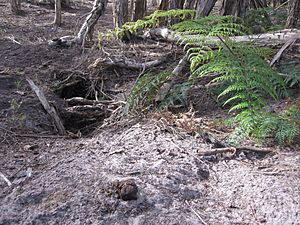
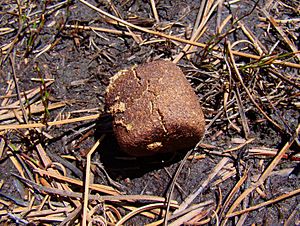
Wombats have a very slow metabolism. It takes them about 8 to 14 days to digest their food. This helps them survive in dry places. They usually move slowly. But if they feel in danger, they can run very fast. They can reach speeds of up to 40 kilometers per hour (25 mph). They can keep this speed for about 150 meters (490 feet).
Wombats protect their home areas around their burrows. They can be aggressive if another animal tries to enter their space. Common wombats can have a home range of up to 23 hectares (57 acres). Hairy-nosed wombats have smaller ranges, usually less than 4 hectares (10 acres).
Dingos and Tasmanian devils sometimes hunt wombats. Wombats have a tough rear end made of cartilage. This is their main defense. It is hard for a predator to bite them if they dive into a tunnel. A wombat might let an attacker follow it into a tunnel. Then, it can use its strong legs to push the attacker's head against the tunnel roof. Or it might kick the attacker away.
Wombats are usually quiet animals. Bare-nosed wombats make more sounds than hairy-nosed wombats. They tend to be louder during mating season. When they are angry, they can make hissing sounds. Their call can sound a bit like a pig's squeal. They also make grunting noises, a low growl, a hoarse cough, and a clicking noise.
Wombat Species
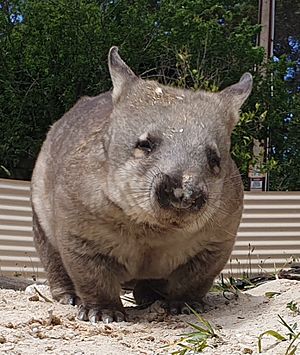
The three types of wombats alive today live only in Australia. They also live on a few islands nearby. All wombats are protected by Australian law.
- Common wombat (Vombatus ursinus)
- Northern hairy-nosed wombat or yaminon (Lasiorhinus krefftii)
- Southern hairy-nosed wombat (Lasiorhinus latifrons)
Wombats and People
Wombats in History
It is rare to find old rock art showing wombats. But some examples up to 4,000 years old have been found. These are in Wollemi National Park. In some Aboriginal stories, the wombat is seen as not very important. Mainland stories say the wombat came from a person named Warreen. This person was punished for being selfish.
The name "wombat" comes from the Dharug language. This language was spoken by the Aboriginal Darug people near Sydney. The name was first written down in 1798. Early European settlers often called wombats "badgers". This was because of their size and how they lived. Some places in Australia are still named after wombats, like Badger Creek. The spelling of "wombat" changed many times over the years.
In 1797, sailors found wombats on Clarke Island. They took a live wombat back to Port Jackson (Sydney). Later, a governor sent the wombat's body to a society in England. They wanted to confirm it was a new animal.
In the early 1900s, wombats were sometimes seen as pests. People were even paid to hunt them. This, along with losing their homes, greatly reduced the number of wombats.
Wombat Encounters
Wombats can scratch or bite humans. If a wombat is surprised, it might charge and bump into a person. This could cause someone to fall. One naturalist, Harry Frauca, was bitten 2 centimeters (0.8 inches) deep into his leg. This happened through his boot and socks. In 2010, a newspaper reported that a man was injured by a wombat. The wombat was thought to be sick.
Wombats in Culture
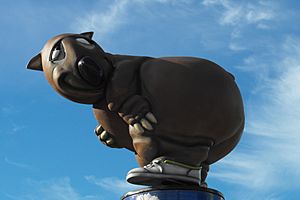
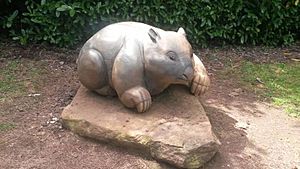
Some farmers think common wombats are a problem. This is mainly because of their digging. "Fatso the Fat-Arsed Wombat" was a funny "unofficial" mascot for the 2000 Sydney Olympics. Since 2005, October 22nd has been an unofficial holiday called Wombat Day.
Wombat meat used to be a food source for both Aboriginal Australians and early Europeans. Now, wombats are protected. So, wombat meat is not a common food in Australia today. Wombat stew was once a well-known Australian dish.
Wombats have been shown on Australian postage stamps and coins. Hairy-nosed wombats often appear to show they are endangered. The northern hairy-nosed wombat was on a 1974 20-cent stamp. The common wombat has been on several stamps too. Wombats are rarely on regular coins. But a 2005 commemorative $1 coin showed a common wombat.
Many places in Australia are named after the wombat. This includes places where wombats no longer live in the wild. For example, the Wombat State Forest and Wombat Hill in Daylesford. The town of Wombat, New South Wales is also named after them. There are also many wombat sculptures.
Wombats have also been on Australian television. A famous pet wombat named Fatso was on the TV show A Country Practice. The TV show Wombat was also named after these animals.
Wombats are in Australian books too. Mr. Walter Wombat is a character in Blinky Bill. A wombat is also a main character in The Magic Pudding.
Wombat Conservation
All types of wombats are protected in most Australian states. Victoria is an exception.
The northern hairy-nosed wombat is an endangered species. This means there are very few of them left. The biggest dangers to them are their small numbers. Also, wild dogs hunt them. They also have less food because of too many cattle and sheep. Diseases are a threat too.
There are only two known wild groups of northern hairy-nosed wombats. One is in Epping Forest National Park in Queensland. The other is a smaller group at the Richard Underwood Nature Refuge. This second group was started by moving wombats there.
The number of wombats in Epping Forest National Park has grown. This is because a fence was built to keep predators out. In 2013, there were 196 of these wombats in the park. By late 2015, the number was expected to be 230 across both locations.
Even though it is called the common wombat, it is not as common as it used to be. It has been a protected animal in New South Wales since 1970. However, in eastern Victoria, they are not protected. Some people there see them as pests. This is especially true because they can damage fences.
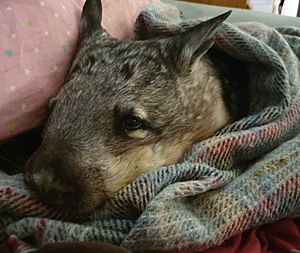
WomSAT is a project where people can help scientists. It started in 2016. People can record where they see wombats. This includes live wombats, dead wombats, or wombat burrows. You can use a website or a phone app. Since it started, over 7,000 sightings have been recorded. These are from New South Wales, Victoria, Tasmania, and South Australia.
The Wombat Awareness Organisation is in the Adelaide hills. It is a non-profit group. They help rescue and care for Southern Hairy-nosed Wombats.
Related Pages
See also
 In Spanish: Vombátidos para niños
In Spanish: Vombátidos para niños


